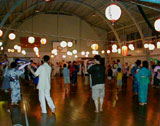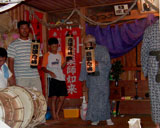Dance in the “borderline” with the another world
As we look at the various “dancing sites”, it seems that at a glance, they choose it at random reflecting the regional characteristics, or choose a right open space.
However, there is a common nature among these traditional dancing sites (“the public space” does not fall into this nature). That is, in most cases they are “a borderline space with the another world”.
“The religious space” is the borderline with the “another world”, but in the old times, “the waterfront space” such as rivers and seas were also considered as the borderline with the community and the contact point with the another world. Also, in the respect that many strangers come and go, “fairs” and “streets” were also considered as special spaces.
We can consider that the reason why the people chose these places as the Bon Dancing site is that they evaluated that “people must dance in the places where it is appropriate to salute and send off the spirits that come to this world from the another world in Bon.”
Bon Dancing that people dance “in doors”
By the way, if we take a look, there are many cases that people dance Bon Dancing in doors all around Japan.
Indoor type dances such as dances that they dance in the hall or in a room are very much different in the image and/or atmosphere if you compare with dances outdoors which they dance under the night sky. Of course the mainstream of Bon Dancing is outdoors, but as a matter of fact, these “indoor type” Bon Dancings have an extremely old history, and they are an interesting theme when you explore the history of Bon Dancing.
We can roughly classify the indoor type into 1.public spaces of mura (villages) such as “the hall of a temple”, “shrine pavillions”, “Buddhist facilities such as Amitabha Halls”, and “community halls”, “tea cottages” and 2.private spaces which they dance in “the houses of the individuals”.
Shirotori Dancing, Shohgawa Bon Dancing in Gifu Prefecture, and Ohmiya Dancing in Okayama Prefecture are famous as the examples for the former type. Above all, a condensed distribution of the Bon Dancings of the indoor type can be seen in the four prefectures of Shikoku island.
Moreover, Totsukawa Bon Dancing (Nishikawa district) has a history that it was danced inside the hall, but nowadays it is danced in the gymnasium of a junior high school which is also a public space.
a href=”https://bonodori.jp/wp-content/uploads/2018/03/kuukan1f_totukawa.jpg”>
Totsukawa Bon Dancing is danced in the gymnasium of a junior high school. (Totsukawa Village Nara Prefecture, 2001/8/15)
*1 The research called “Sadoh no Shuhzoku 1,2 (The folkways of Tea Cottages)” compiled by the Agency of Cultural Affairs, introduces the fact that events such as Bon Dancing and Nembutsu Dancing were held in the old community facilitiy called “Sadoh (Tea Cottage)”which were usually used for receptions of the people on a pilgrimage mainly in the Shikoku region.
*2 An old dance called “Kami odori (god dance)” is introduced in “Tokushima-ken minzoku geinohshi (magazine of folk arts in Tokushima prefecture)” published by Kinseidoh, and it reports the image of Bon Dancing of the indoor type which are danced in the halls of the villages.
Nembutsu Dancing is also a public entertainment that is frequently danced indoors. We can consider an assumption that Bon Dancings which requires a larger space are gradually held outdoors, and Nembutsu Dancings which have a stronger religious factor and as its participants are limited, remained as indoor dances. This is one of the themes that we would like to pursue further.
If we look from the historical point of view, Odori Nembutsu (Nembutsu Dancing) of Saint Ippen which is considered to be one of the headstreams of Bon Dancings, they frequently dance indoors. Also, Ippen Hijirie (Religious picture scroll of Saint Ippen) portrays most scenes of Odori Nembutsu as images dancing on makeshift Odori Yakata.*

Nishiura Nembutsu Dancing danced in the Amitabha Hall (Muzukubo-cho Shizuoka prefecture, 2003/8/16)
* In the house of Ohi in Shinshu region, where it is said that Saint Ippen danced Odori Nembutsu for the first time, there is an anecdote that since the people danced so wildly, the floor of the house crumbled.
Also, if we view the old records, in early 16th century, which was also the beginning of Bon Dancing, in Nanto (Nara), people always danced in the hall of Yakushi Temple, but as people danced so aggressively, “The hall swayed and the roof tile fell off, and ruined the Buddha statutes”. Therefore, they decided to build a dance hall for exclusive use of dancing.
This fact shows the history of indoor type Bon Dancing, and it is also hands down the enthusiasm of the people at that time to Bon Dancing.
